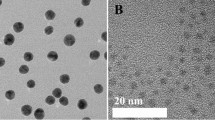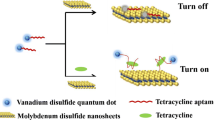Abstract
A rapid and sensitive aptamer-based assay is described for kanamycin, a veterinary antibiotic with neurotoxic side effects. It is based on a novel FRET pair consisting of fluorescent carbon dots and layered MoS2. This donor-acceptor pair (operated at excitation/emission wavelengths of 380/440 nm) shows fluorescence recovery efficiencies reaching 93 %. By taking advantages of aptamer-induced fluorescence quenching and recovery, kanamycin can be quantified in the of 4–25 μM concentration range, with a detection limit of 1.1 μM. The method displays good specificity and was applied to the determination of kanamycin in spiked milk where it gave recoveries ranging from 85 % to 102 %, demonstrating that the method serves as a promising tool for the rapid detection of kanamycin in milk and other animal-derived foodstuff.

A fluorometric aptasensor was developed for the determination of kanamycin. It is based on a novel FRET pair of carbon dots and layered MoS2. The fluorescence recovery efficiency reached 93 % with a good sensitivity, specificity and recoveries in spiked milk.





Similar content being viewed by others
References
Jin Y, Jang WJ, Han CH, Lee MH (2006) Development of immunoassays for the detection of kanamycin in veterinary fields. J Vet Sci 7(2):111–117
U.S. National Library of Medicine http://dailymed.nlm.nih.gov/
Song KM, Cho M, Jo H, Min K, Jeon SH, Kim T, Han MS, Ku JK, Ban C (2011) Gold nanoparticle-based colorimetric detection of kanamycin using a DNA aptamer. Anal Biochem 415(2):175–181
Xing YP, Liu C, Zhou XH, Shi HC (2015) Label-free detection of kanamycin based on a G-quadruplex DNA aptamer-based fluorescent intercalator displacement assay. Sci Rep 5:8125
Zhu Y, Chandra P, Song KM, Ban C, Shim YB (2012) Label-free detection of kanamycin based on the aptamer-functionalized conducting polymer/gold nanocomposite. Biosens Bioelectron 36(1):29–34
Tombelli S, Minunni M, Mascini M (2007) Aptamers-based assays for diagnostics, environmental and food analysis. Biomol Eng 24(2):191–200
Liu J, Guan Z, Lv Z, Jiang X, Yang S, Chen A (2014) Improving sensitivity of gold nanoparticle based fluorescence quenching and colorimetric aptasensor by using water resuspended gold nanoparticle. Biosens Bioelectron 52:265–270
Wu S, Duan N, Ma X, Xia Y, Wang H, Wang Z, Zhang Q (2012) Multiplexed fluorescence resonance energy transfer aptasensor between upconversion nanoparticles and graphene oxide for the simultaneous determination of mycotoxins. Anal Chem 84(14):6263–6270
Tianyu H, Xu Y, Weidan N, Xingguang S (2016) Aptamer-based aggregation assay for mercury (II) using gold nanoparticles and fluorescent CdTe quantum dots. Microchim Acta 183(7):2131–2137
Wang GL, Hu XL, Wu XM, Dong YM, Li ZJ (2016) Fluorescent aptamer-based assay for thrombin with large signal amplification using peroxidase mimetics. Microchim Acta 183(2):765–771
Yi Z, Li XY, Gao Q, Tang LJ, Chu X (2013) Aptamer-aided target capturing with biocatalytic metal deposition: an electrochemical platform for sensitive detection of cancer cells. Analyst 138(7):2032–2037
Tan W, Donovan MJ, Jiang J (2013) Aptamers from cell-based selection for bioanalytical applications. Chem Rev 113(4):2842–2862
Song S, Wang L, Li J, Fan C, Zhao J (2008) Aptamer-based biosensors. TrAC Trends Anal Chem 27(2):108–117
Chen T, Shukoor MI, Chen Y, Yuan Q, Zhu Z, Zhao Z, Basri G, Tan W (2011) Aptamer-conjugated nanomaterials for bioanalysis and biotechnology applications. Nanoscale 3(2):546–556
Zhang C, Yuan Y, Zhang S, Wang Y, Liu Z (2011) Biosensing platform based on fluorescence resonance energy transfer from upconverting nanocrystals to graphene oxide. Angew Chem Int Ed 50(30):6851–6854
Li W, Yang X, Wang K, Tan W, Li H, Ma C (2008) FRET-based aptamer probe for rapid angiogenin detection. Talanta 75(3):770–774
Shi L, De Paoli V, Rosenzweig N, Rosenzweig Z (2006) Synthesis and application of quantum dots FRET-based protease sensors. J Am Chem Soc 128(32):10378–10379
Duan N, Wu S, Dai S, Miao T, Chen J, Wang Z (2015) Simultaneous detection of pathogenic bacteria using an aptamer based biosensor and dual fluorescence resonance energy transfer from quantum dots to carbon nanoparticles. Microchim Acta 182(5–6):917–923
Yu C, Li X, Zeng F, Zheng F, Wu S (2013) Carbon-dot-based ratiometric fluorescent sensor for detecting hydrogen sulfide in aqueous media and inside live cells. Chem Commun 49(4):403–405
Dai H, Shi Y, WangY SY, Hu J, Ni P, Li Z (2014) A carbon dot based biosensor for melamine detection by fluorescence resonance energy transfer. Sensors Actuators B Chem 202:201–208
Yang R, Jin J, Chen Y, Shao N, Kang H, Xiao Z, Tang Z, Wu Y, Zhu Z, Tan W (2008) Carbon nanotube-quenched fluorescent oligonucleotides: probes that fluoresce upon hybridization. J Am Chem Soc 130(26):8351–8358
Zhu C, Zeng Z, Li H, Li F, Fan C, Zhang H (2013) Single-layer MoS2-based nanoprobes for homogeneous detection of biomolecules. J Am Chem Soc 135(16):5998–6001
Ding J, Zhou Y, Li Y, Guo S, Huang X (2016) MoS2 nanosheet assembling superstructure with a three-dimensional ion accessible site: a new class of bifunctional materials for batteries and electrocatalysis. Chem Mater 28(7):2074–2080
Ge J, Ou EC, Yu RQ, Chu X (2014) A novel aptameric nanobiosensor based on the self-assembled DNA–MoS2 nanosheet architecture for biomolecule detection. J Mater Chem B 2(6):625–628
Singh P, Gupta R, Sinha M, Kumar R, Bhalla V (2016) MoS2 based digital response platform for aptamer based fluorescent detection of pathogens. Microchim Acta 183(4):1501–1506
Wang K, Wang J, Fan J, Lotya M, O’Neill A, Fox D, Feng Y, Zhang X, Jiang B, Zhao Q, Zhang H, Coleman JN, Zhang L, Zhang H (2013) Ultrafast saturable absorption of two-dimensional MoS2 nanosheets. ACS Nano 7(10):9260–9267
Li BL, Luo HQ, Lei JL, Li NB (2014) Hemin-functionalized MoS2 nanosheets: enhanced peroxidase-like catalytic activity with a steady state in aqueous solution. RSC Adv 4(46):24256–24262
Guo Y, Wang Z, Shao H, Jiang X (2013) Hydrothermal synthesis of highly fluorescent carbon nanoparticles from sodium citrate and their use for the detection of mercury ions. Carbon 52:583–589
National Standard of China. Determination of streptomycin, dihydrostreptomycin and kanamycin residues in milk and milk powder–LC-MS-MS method. GB/T 22969–2008
Nicolosi V, Chhowalla M, Kanatzidis MG, Strano MS, Coleman JN (2013) Liquid exfoliation of layered materials. Science 340(6139):1226419
Splendiani A, Sun L, Zhang Y, Li T, Kim J, Chim CY, Galli G, Wang F (2010) Emerging photoluminescence in monolayer MoS2. Nano Lett 10(4):1271–1275
Beal AR, Knights JC, Liang WY (1972) Transmission spectra of some transition metal dichalcogenides. II. Group VIA: trigonal prismatic coordination. J Phys C Solid State Phys 5(24):3540
Cui X, Zhu L, Wu J, Hou Y, Wang P, Wang Z, Yang M (2015) A fluorescent biosensor based on carbon dots-labeled oligodeoxyribonucleotide and graphene oxide for mercury (II) detection. Biosens Bioelectron 63:506–512
Liu C, Lu C, Tang Z, Chen X, Wang G, Sun F (2015) Aptamer-functionalized magnetic nanoparticles for simultaneous fluorometric determination of oxytetracycline and kanamycin. Microchim Acta 182(15–16):2567–2575
Acknowledgments
This work is supported by the National Science & Technology Pillar Program of China (No. 2014BAD13B05) and the Yangling Agricultural Hi-tech Industries Demonstration Zone (2014NY-35).
Author information
Authors and Affiliations
Corresponding authors
Ethics declarations
The author(s) declare that they have no competing interests.
Rights and permissions
About this article
Cite this article
Wang, Y., Ma, T., Ma, S. et al. Fluorometric determination of the antibiotic kanamycin by aptamer-induced FRET quenching and recovery between MoS2 nanosheets and carbon dots. Microchim Acta 184, 203–210 (2017). https://doi.org/10.1007/s00604-016-2011-4
Received:
Accepted:
Published:
Issue Date:
DOI: https://doi.org/10.1007/s00604-016-2011-4




